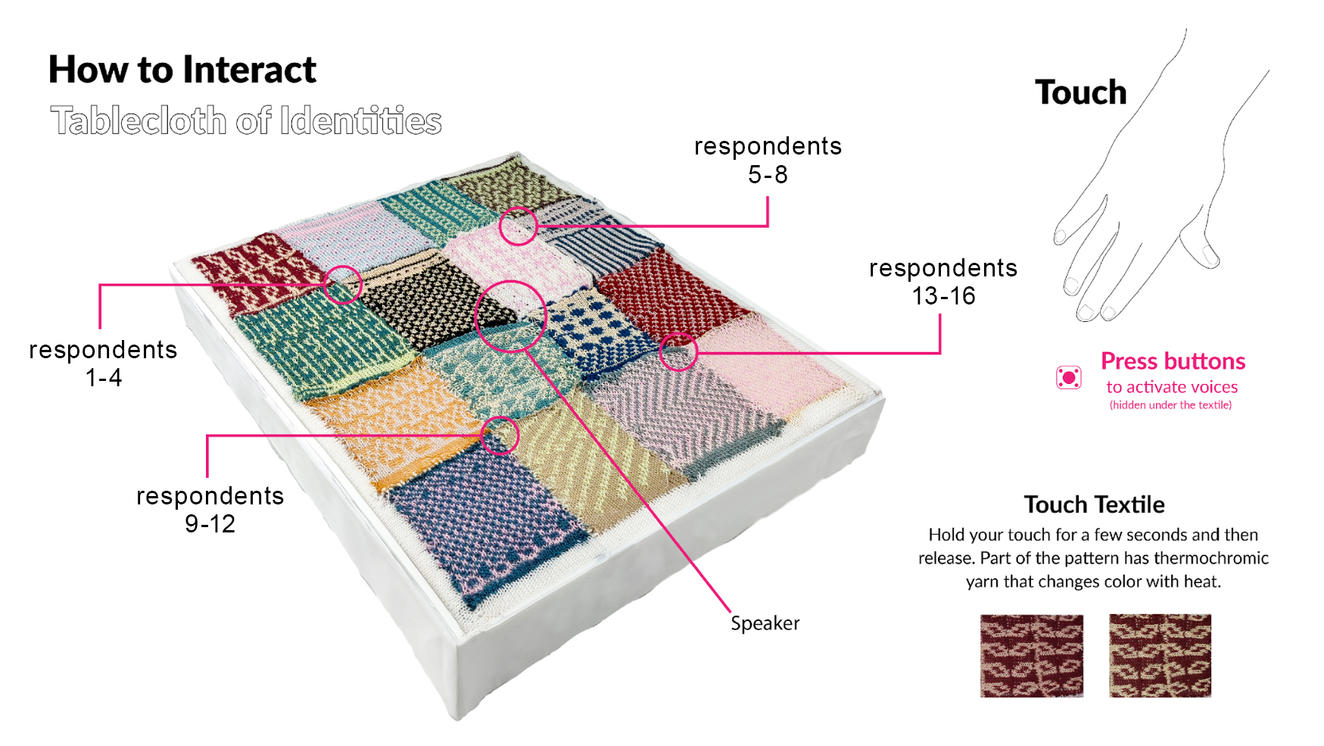We were inspired by the Paracas mantle because it has become fragments that are dispersed all around the world without context. Context is important when it comes to creating work and exhibiting it.
Through our tablecloth, we are bringing people together who are from different backgrounds and areas around the world. The context of meals creates spaces for conversation, joy, understanding, and inclusivity. Although the people we have invited are not all with us in Providence, they have had an active role in our making process. We asked seven people each (and included ourselves) to join our conversational piece by asking them to fill out an excel sheet that we made into a pattern on a physical punchcard. Isa, with an expertise in textiles, used a knitting machine to make them come to life. We were interested in what role the actual fibers of the piece could play. We experimented with thermochromic pigment dyes to dye the yarn in order to ephemerally present that there were people present who interacted with our tablecloth. Although this is at a smaller scale than a full table-length table cloth, it materializes and emulates the emotions and commemorates togetherness.
Although inspired by the fragmented pieces at the RISD Museum, we wanted to create something whole again from dispersed pieces instead. This is something that we would like to see happen with museum pieces like the Paracas mantle because colonialism thrives from separation, isolation, and detachment—which we want to do the opposite of.
Throughout the weeks we have met up several times for lunch or dinner, with other people or just us two. They were not planned meals; it felt very natural and it coincided with the project we are working on together. We found common similarities in places we have visited and places we will go to in the near future.
There is a sound element to our piece because meals are not silent. We invite the viewers to interact with our project by not only touching the sound buttons to hear the voices of our participants, but also to create ephemeral warmth when touching the yarn.
— Carmen
The Paracas mantle and Gee's Bend patchwork quilt that we viewed at the RISD Museum, although disparate in nature, contexts, and techniques, have various similarities on the topic of fragmentation, dispersion, reunion, and reconciliation. The multiple fabrics in the quilted piece, pertaining to different individuals from a community, are reconciled together in a new form, repurposed and given a new life through the essence and history of the people whose fabrics and clothes have been patched and sewn together. On the other hand, the Paracas mantle, although visually and technically composed of multiple pieces, was crafted as an individual piece that was dismantled through processes of looting and illegal trading to other countries. This dispersal has affected its original context and audience within museum environments. Recent conversations about repatriation and return of the fragments of Paracas textiles to Peru are in contrast with the dispersal and reunion present in the quilt. Instead of repurposing those fragments into a new-formed life, the Paracas piece was cut across its warps and wefts in an attempt to capitalize on its cultural significance. However, repatriation attempts to bring those pieces together are of great importance and returning these pieces to their cultures of origin would be a form of restorative justice. Differently from the quilt, the separation of fabric has been on a larger geographic scale, across multiple borders and countries.
The inspiration brought from these two pieces in conversation with each other has been embodied through the lived experiences of Isabela and Carmen as individuals from diverse cultural backgrounds and connections to many geographic locations, cultures, and individuals. Our similarity of lived experiences in Brazil and presently in Rhode Island has been a great influence on the work developed. As creative individuals experiencing physical movement across cultural boundaries, and maintaining relationships with individuals across the world, we aimed to compile these connections in the digital world and materialize that information in the form of fabric. The relation to the selected artworks has brought us to question how the connection to a collective of individuals could be brought into the same environment. There is a warmth in having a community of bodies, breath, and conversation present during a shared meal, including that which fabric provides by bringing people together. Although the digital space and technological devices seem to dominate and hegemonize our interactions, how could it be dismantled and decolonized to enable different fingerprints and identities to come together and take shape in a tablecloth that constitutes a collective identity and invites others to participate?
— Isa
Carmen Belmonte Sandoval is a senior at RISD studying industrial design and concentrating in Nature–Culture–Sustainability Studies.
Isabela C. is a junior at RISD studying textiles and also concentrating in Nature–Culture–Sustainability Studies.

